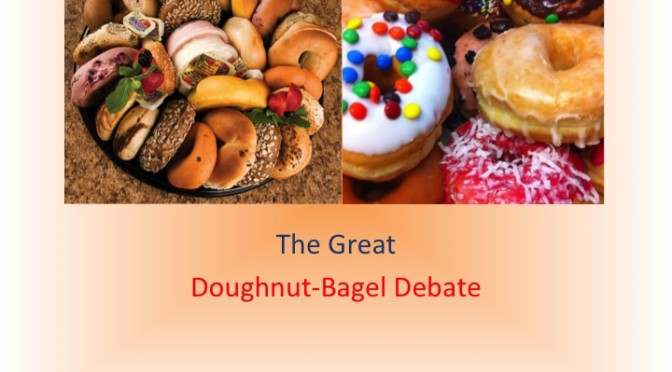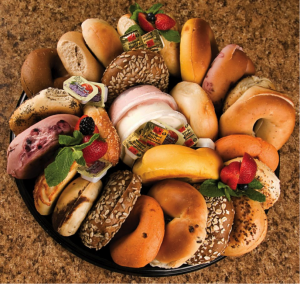*In this special joint post, UCWbLers and CMWR members Kiernan G. and Monisa A. explore what the difference is between a bagel and a doughnut and take opposite sides on which is better. Ready: debate!*
Paying Homage to a Doughnut, an International Treasure
By Kiernan G.
“Doughnuts. Is there anything they can’t do?” Matt Groening, famed creator and cartoonist of The Simpsons, once posed this question. Before we answer this borderline existential question, we must ask a more basic one: what exactly is a doughnut?
Merriam-Webster’s Dictionary defines a doughnut as “a piece of sweet fried dough that is often shaped like a ring.” The key within this definition is that it is often shaped like a ring. Unlike its cousin, the bagel, the doughnut is not constricted to one shape. When we think of doughnuts, it sometimes seems like they are limited to just a ring of fried dough and sugar that you pick up from Dunkin’ Donuts on your way to class. However, if we look back at the definition, the doughnut is so much more. It can come in various shapes and flavors, and you can even add filling. You can even get really crazy and add sprinkles. The doughnut, in other words, is rather versatile, and, as we will see, it is a treat that travels the world.
There are various types of “doughnuts” that find their home in various areas of the world. For example, there is the French beignet, a light square of dough typically sprinkled with powdered sugar. It can be enjoyed with a cup of espresso or even a crisp glass of champagne. There is also the Spanish churro, which is more tube shaped, but is made from unsweetened dough and sprinkled with sugar. A churro can be filled with certain flavored jellies or creams as well. (Tip: dip a churro in Nutella and prepare to give your taste buds the adventure they have been longing for).
The pączki from Poland is also an interesting and delicious example of an international doughnut. It is a deep-fried piece of dough and is typically filled with a sweet filling. Like the beignet, the pączki is usually sprinkled with powdered sugar.
These are only a few of the representations of doughnuts from around the world. A doughnut is not specifically “American” or even something that Dunkin’ Donuts can claim as their own. Doughnuts are so much more than a box of a dozen fried doughy rings. A doughnut is a universal treat in its own right, and the doughnut’s combination of sugar and dough has clearly struck a chord with people from all around the world … which ultimately makes the doughnut something truly special. A treasure, even.
The bagel, on the other hand, is a very different kind of food. Merriam-Webster’s Dictionary defines it as “a bread shaped like a ring.” Unlike the doughnut, a bagel does not have sprinkled sugar and tends to be more condensed in texture compared to a doughnut. People often use bagels as a breakfast food or even as a substitute for flatbread for sandwiches. There are some who argue that bagels are superior to doughnuts, but I would argue that doughnuts are more versatile, more adaptable than bagels, therefore making doughnuts superior to bagels.
As we saw, the doughnut is interpreted differently in various areas of the world. This is due to the doughnut’s basic ingredients, which can easily be manipulated and molded into a plethora of shapes and sizes. With a doughnut, you can add sprinkles, sugar, cream, jelly … really anything that strikes your fancy. The bagel lacks the same versatility. The sugar and fried dough combination of a doughnut acts as a burst of flavor that tantalizes one’s taste buds, leaving a bagel seem more like just a bland, naked doughnut. Overall, it is the doughnut’s versatility of shape and tastes that makes it so transferable in other countries, and that is why we have the beignet, the churro, and the pączki. The bagel does not have the same track record, ultimately making it a more basic food.
This essentially brings us full doughnut-circle to the question posed by Mr. Groening at the beginning of this post: “Doughnuts. Is there anything they can’t do?” No, there is nothing a doughnut cannot do. It can travel the world and satisfy your hunger pretty much anywhere you go, even if there isn’t a Dunkin’ Donuts in sight. The versatility of a doughnut makes it incredibly special and unique, and for that, doughnuts, we thank you!
A Written Ode to the Bagel
By Monisa A.
While that may be so, dear Kiernan, what the international community at DePaul wants is dedication, versatility, health, and comfort. Not unlike what we here at the UCWbL, and more specifically the CMWR, offer so lovingly.
My standing argument? Any bagel that bagels is a bagel: The bagel is representative of the UCWbl at large and thus stands as the superior round bread-food.
Now, I know what you’re thinking: that my four years in a liberal institution have taught me to think of mundane objects and television shows in elaborate metaphors and that I’m literally crazy. But hear me out on this one.
We at the UCWbL are all about inclusion. So are bagels. Unlike the doughnut—fried, oversaturated, overhyped, and slightly unvarying in terms of flavor—bagels come in innumerable varieties, much like writers (and their needs) do. No matter the task or a writer’s progress, we as tutors facilitate the notion that there is no conclusive universal writing process. We emulate changes and differences, strive for new and exciting ways to approach our duties, and collaborate to accomplish goals like no other.
Truly, does the bagel not emulate those very pride-worthy qualities? It’s modest in its variations—from the sweet blueberry to the savory garlic to the fancier bialy—and humble in its possibilities. (Cream cheese? Some other spread? Salmon? Leftover meats? That fruit in the back of your refrigerator you’ve been meaning to use up since you regrettably were lured in by the samples at Whole Foods? Put it on a bagel.). Through the collaborative efforts that make bagel sandwiches so detailed and delightful, bagels can be consumed guilt-free at any time—and built upon to satisfy whatever one’s specific needs are.
And is that not what we hope to achieve with our tutoring? To morph and fit to a writer’s needs (be they sweet or savory), and collaboratively build upon each other’s ideas to create a unique piece worth being proud about? Clearly, bagels are the more versatile and tutoring-relevant choice of ring-shaped bread.
—
In the end, who would think that two little dough-wads would differ so drastically in calories and purpose? Both are devised from a flour base. Both contain similar ingredients.
But just as beautiful flowers and poison ivy grow within the same forest path, so do bagels and doughnuts in the humble kitchens, pantries and bakeries of this land—each with stunning nutritional values and differences.





One reply on “Doughnut vs. Bagel: The CMWR Debate”
I would like to submit this as my rebuttal for Monisa’s critique of the doughnut
https://33.media.tumblr.com/c05b6576e2519c9cd6cc253f4c22ae98/tumblr_inline_n7otpx332n1qg76de.gif